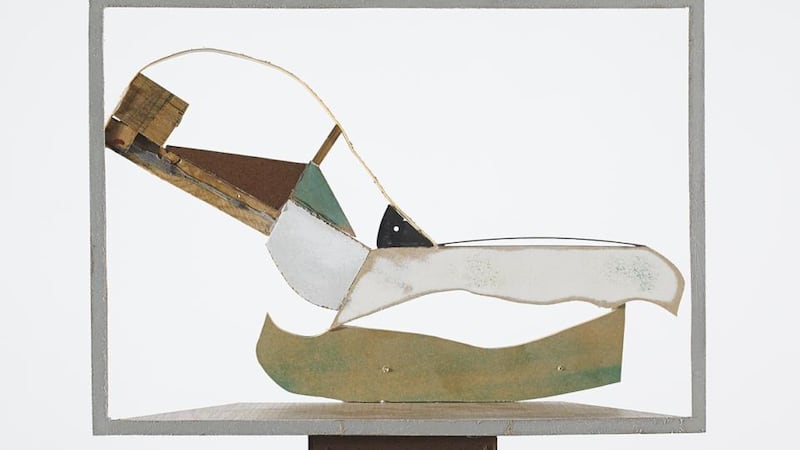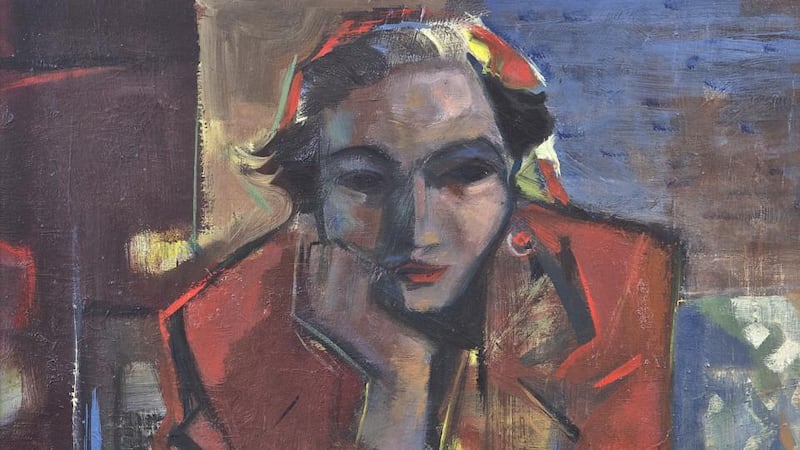Pictures from the Surface – Tadhg McSweeney
Kevin Kavanagh Gallery, Dublin
*****


One of the most exciting moments in the history of modern art was the hectic, competitive collaboration between Braque and Picasso that jump-started cubism towards the end of the first decade of the 20th century. Other artists played roles in the development of cubism, but there is something magical about the raw, inspired inventiveness of the pair over a several-year period that sets them apart from the others. As Braque famously commented, they were like mountaineers, roped together.
Cubism disassembled the conventions of perception and representation and created a new way of seeing the world. Along the way, the practice of collage became increasingly important, indirectly at first through the incorporation of hand-painted renderings of printed text and decorative techniques such as wood-graining and marbling, and then through the inclusion of paper, newsprint, wallpaper and other fragments of materials glued to surface.
Picasso went further, however, eventually reaching beyond the surface and inventing something quite new: constructed sculptures.
Fast-forward a little over a century and a similar trajectory is evident in Tadhg McSweeney’s work. Painting per se used to play a central role, but gradually it has ceded to the collaged elements that were always part of his process. Latterly he’s been making constructed, often kinetic sculptures that could well be described as sculptural collages with painterly elements. All manner of found and cast-off materials and fragments are pressed into service in each composition.
If you were lucky enough to see his Edifice Complex at Visual Carlow in 2013, you'll appreciate the surprising potential of his apparently modest method and materials. Never for a moment appearing overshadowed by the main gallery's vast interior, his inter-related installations conjured up the dynamic workings of a labyrinthine metropolis. The sense of utopian ambition was unmistakable, and he has acknowledged his liking for the heady idealism of the era of early Soviet abstraction, when it seemed briefly as if artists might be at the heart of the project of remaking the world.
Again though, McSweeney is working close to a century later, when the utopian promises of both modernity and revolutionary Russia have long been broken. His work addresses this brokenness in the world, as though he is sifting through the remnants of a failed past with hopes of fashioning something better for the future. Hence, one is tempted to deduce, his liking for off-cuts and cast-offs, for by-products and detritus.
There’s an implicit argument for recycling and sustainability in how he does what he does.
An improviser of brilliance, he takes stuff that is to hand and combines and transforms it with minimal intervention. The physical lightness of the pieces belies their visual and conceptual richness. Presented with what at first glance might appear as just a few deft touches and flourishes, it’s as if our eyes have been quietly primed to fill in the blanks, to flesh out the picture. Dimensions multiply and we are drawn into intricate landscapes captured in multiple, shifting frames, urban and rural, earthly and floating high above the earth, and delving into geological layers below. The show is a delight.
[ kevinkavanagh.ieOpens in new window ]
George Campbell and the Belfast Boys – Adam’s sixth summer exhibition
Adam’s, Dublin
****
Adam's summer loan exhibition, George Campbell and the Belfast Boys, revisits a chapter of mid-20th century Irish art history and concentrates, as the title suggests, on George Campbell. Curator Karen Reihill has rounded up a very good, representative selection of work by him, plus fewer – though substantial – examples by several figures associated with him, including his close friend Gerard Dillon, Arthur Armstrong and Daniel O'Neill.
All flourished at a time when Irish artists were exploring their own cultural identities in the context of the arrival of European, modernist ideas. The situation of Northern Irish artists was further complicated by the Border. They were notionally part of the UK. Theoretically that should have opened doors for them, but in practice the province remained firmly provincial, culturally. It's no wonder that many Northern artists looked to the South or, more to the point, the west. Campbell, Dillon and Armstrong all found a place apart, an ideal working space to develop their work and ideas in the west of Ireland.
Campbell went farther afield, to Spain, eventually spending half of each year in a village close to Malaga. His sympathy for the Spanish temperament and music is clear and positive in his painting. The range and quality of his work on view amount to a mini-retrospective. Armstrong comes across very well, especially in his powerfully tactile paintings from Connemara. There are several really good works by Dillon. Less convincing is the perennial auction favourite O'Neill.
The argument that Campbell, an enormously energetic, enterprising figure and for a time a very successful and popular artist, is now under-rated and neglected, is mildly persuasive – but only mildly. He is well-known to those with even a passing familiarity with Irish art history, and seasoned collectors of Irish art are well aware of him. Armstrong is perhaps more unfairly neglected.
What comes across strongly is the enlivening sense of art as personally liberating and creatively challenging for the trio. Looking at their work, you get the feeling that, for them, art was about the fullness of life, that there were no boundaries and everything was up for grabs. Surprisingly, that is rare nowadays, and it is invigorating to encounter.













